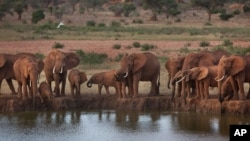Illegal trade in ivory is at its highest levels in nearly two decades, and 2011 witnessed a ‘major surge’, according to a report released last month by the Convention on International Trade in Endangered Species of Wild Fauna and Flora (CITES).
The findings, largely based on ivory seizure information submitted by governments, will be presented and discussed at the 16th meeting of the Conference of the Parties to CITES to be held in Bangkok, Thailand from 3 to 14 March 2013.
The report analyzes data from the Elephant Trade Information System (ETIS) managed by the wildlife trade monitoring organization known as TRAFFIC. In 2011 alone, there were 17 large-scale ivory seizures — more than double the highest previous figure of eight, in 2009, and totaling an estimated 26.4 tons of ivory. Complete figures are not yet available for 2012.
“The remarkable surge in recent years reflects the increasing involvement of organized crime syndicates in the illegal ivory trade,” said Tom Milliken, lead author of the report to CITES.
Commenting on the critical situation currently facing African elephants, the CITES Secretary-General, Mr. John E. Scanlon, said: “We need to enhance our collective efforts across range, transit and consumer States to reverse the current disturbing trends in elephant poaching and ivory smuggling.”
According to the report, the most important end use markets driving illegal ivory trade are in Asia.
Trade patterns have shifted to Indian Ocean seaports. With unprecedented frequency, large-scale ivory shipments have either been seized in Kenya and the United Republic of Tanzania or exited Africa through ports in those countries. South Africa is also a country of concern for large flows of ivory, according to the ETIS report.
According to the report, ivory traffickers appear to be targeting Malaysia, along with the Philippines, Hong Kong and Viet Nam, as key transit points along the smuggling chain.
The critical situation demonstrates the urgent need to implement and monitor the African Elephant Action Plan, created by all African Elephant range States under the auspices of CITES in 2010.
The United States is committed to working with its international partners to protect Africa’s endangered elephants, and is currently working with countries in the Horn of Africa and central Africa to develop regional wildlife enforcement networks to strengthen and coordinate efforts to halt the illegal wildlife trade.
The findings, largely based on ivory seizure information submitted by governments, will be presented and discussed at the 16th meeting of the Conference of the Parties to CITES to be held in Bangkok, Thailand from 3 to 14 March 2013.
The report analyzes data from the Elephant Trade Information System (ETIS) managed by the wildlife trade monitoring organization known as TRAFFIC. In 2011 alone, there were 17 large-scale ivory seizures — more than double the highest previous figure of eight, in 2009, and totaling an estimated 26.4 tons of ivory. Complete figures are not yet available for 2012.
“The remarkable surge in recent years reflects the increasing involvement of organized crime syndicates in the illegal ivory trade,” said Tom Milliken, lead author of the report to CITES.
Commenting on the critical situation currently facing African elephants, the CITES Secretary-General, Mr. John E. Scanlon, said: “We need to enhance our collective efforts across range, transit and consumer States to reverse the current disturbing trends in elephant poaching and ivory smuggling.”
According to the report, the most important end use markets driving illegal ivory trade are in Asia.
Trade patterns have shifted to Indian Ocean seaports. With unprecedented frequency, large-scale ivory shipments have either been seized in Kenya and the United Republic of Tanzania or exited Africa through ports in those countries. South Africa is also a country of concern for large flows of ivory, according to the ETIS report.
According to the report, ivory traffickers appear to be targeting Malaysia, along with the Philippines, Hong Kong and Viet Nam, as key transit points along the smuggling chain.
The critical situation demonstrates the urgent need to implement and monitor the African Elephant Action Plan, created by all African Elephant range States under the auspices of CITES in 2010.
The United States is committed to working with its international partners to protect Africa’s endangered elephants, and is currently working with countries in the Horn of Africa and central Africa to develop regional wildlife enforcement networks to strengthen and coordinate efforts to halt the illegal wildlife trade.

















